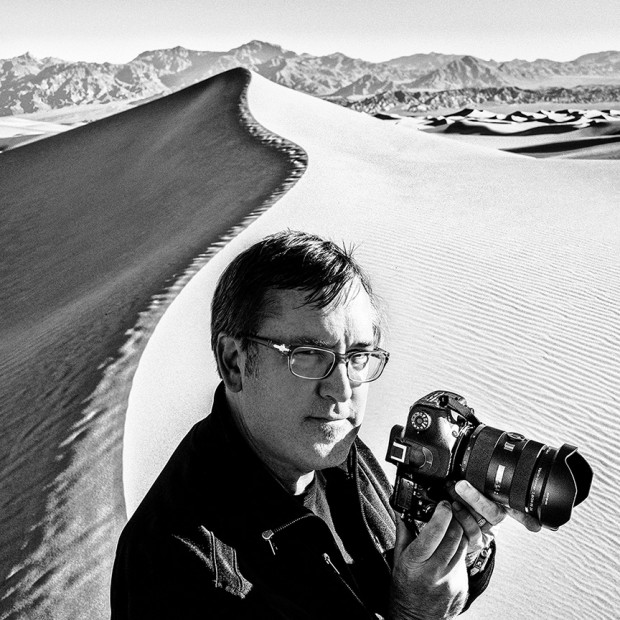
Miami celebrity portrait photographer Brian Smith
[Note from Brad: This is the first of four guest blogs from newer Photoshop World instructors in the weeks leading up to the conference. We thought you might like to get familiar with them beforehand if you’re not already, so we hope you enjoy this series!]
Not every picture is worth a thousand words. The value of an image depends on how much you give it to say.
Conceptual Portrait Photography is creating story-telling portraits that say something about your subject. I'm very excited to join the faculty of Photoshop World in Las Vegas this September 4-6 where I'll be speaking about creating story-telling Conceptual Portrait Photography. In the mean time, Scott and Brad have been kind enough to hand me the keys to O'Kelby's Pub for Happy Hour Wednesday. So grab a pint, slide up to the bar and enjoy a few appetizers.
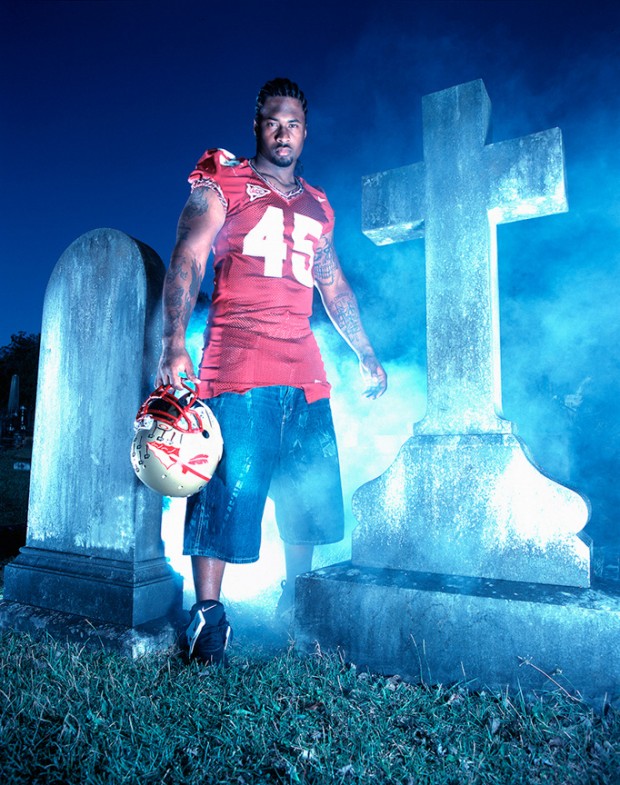
Darnell Dockett photographed for Sports Illustrated
Concepts come from many different places. They can be yours or they can come from the creative director, art director or photo editor. They can be based on the subject's latest movie, project or book. Sometimes they come out of collaboration with the subject and occasionally you just have to pull them out of thin air on the spur of the moment.
Let's start with a concept that I was hired to shoot. Sports Illustrated assigned me to photograph Florida State defensive end Darnell Dockett in a cemetery for their Halloween issue.
I pictured something like the nighttime graveyard scene in Michael Jackson's Thriller video. When shooting college or pro athletes for magazines, you rarely have control over when you'll be able to shoot them. The only time Dockett was available was 3pm in the afternoon. If you've ever been in Tallahassee, Florida in October, you know that harsh afternoon sunlight looks nothing like the ghoulish evening sky we were after.
The key to pulling off the concept boils down to problem solving. We hired an assistant in Tallahassee and put him to work finding the funkiest old cemetery in town.
"Day for night" is a cinematic term for faking a nighttime shot during the day. We chose a spot in the cemetery that would be in full shade so I wouldn't have to fight the sunlight. To give a "Thriller"-esque feel to our daylight shoot, we rented a generator and fog machine.
Using a stand-in for Darnell until he arrived, we pre-lit the shot with three Profoto 7B strobes. The main light was from a Profoto 7B with a beauty dish on the right. A second 7B strobe head with a zoom reflector was just off the ground on the left side of the shot to light up the tombstone on the left and also put a small highlight on Darnell's helmet. A third 7B with a zoom reflector was placed on the ground behind the tombstones to backlight the fog. The bright blue sky was underexposed three stops and white balance was set to tungsten to give the photograph a nighttime feel.

Bill Gates photographed for Business Week
The small stuff can make or break a shoot. Styling is the polish that really makes your concept sing. Back in the early 90s, Business Week called with a cover shoot for Bill Gates. Their concept was to shoot Gates as "Master of the Technology Universe" posed in front of a starry night sky backdrop - a bit over the top - but what the hell, it’s a cover.
Back in those days Gates was never photographed in anything but his trademark button-down shirt and sweater vest, which doesn't exactly scream master of the universe. My wife Fazia, the stylist on our shoot, pulled out a black turtleneck for Gates figuring if we could convince him to wear it, the look would be a better match for the magazine's concept. Gates' assistant was positive he wouldn't wear the turtleneck, but she took it with her anyway. Fifteen minutes later Gates showed up in the black turtleneck and did everything I asked without a word of complaint.
Gates never adopted our look, but a few years later his archrival Steve Jobs didâ¦so maybe Apple was finally able to steal something back from Microsoft.
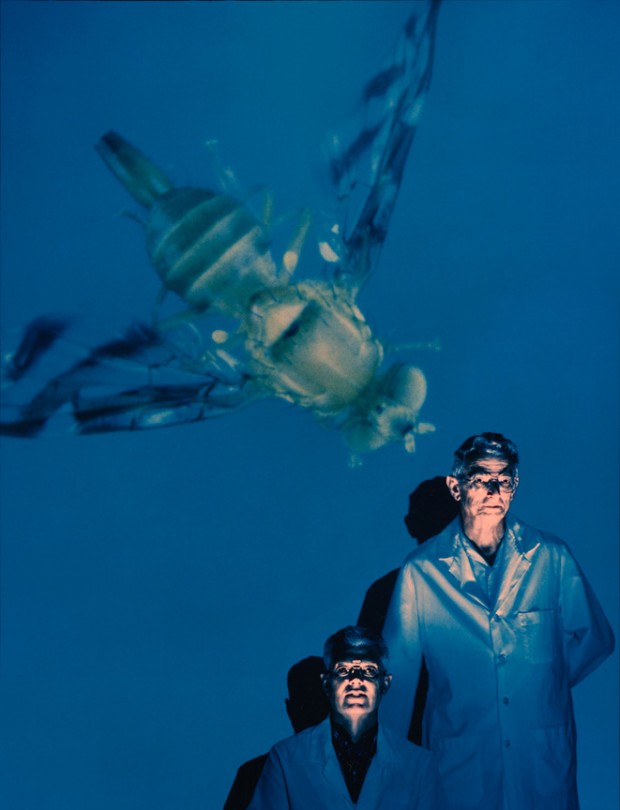
Fly-Sci photographed for Eating Well
Illustrating a small subject on a large scale requires some photographic trickery. Sometimes the best thing to do is turn to your subjects for help. I was at a loss for how to illustrate this story about scientists who irradiate fruit flies, so I asked them for suggestions. When they showed me a slide they use in their lectures, the wheels began to turn. Images of brilliantly bad 1950’s Sci-Fi B movies started to run through my brain. I asked if they had a room with a projector, and they led me to a lecture hall with a wall-sized projection screen. I asked the scientists to don their lab coats and stand in front of the screen so they'd be illuminated by the projected slide. Their faces were lit from below with a little burst of light from using strobe heads fitted with 5-degree grid spots. The color came from cross-processing color negative film as chrome, producing the weird blue/orange shift.
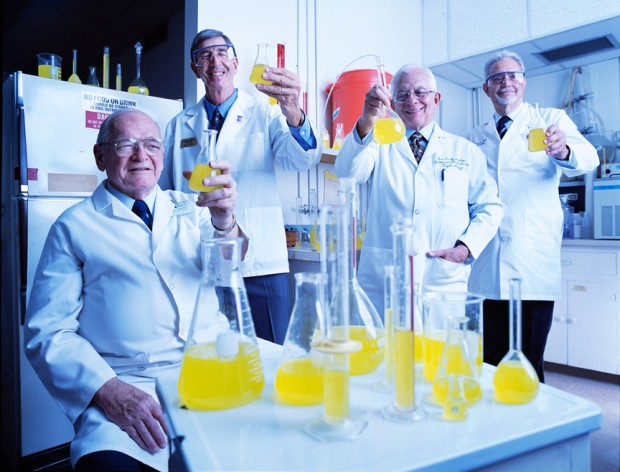
Gatorade Inventors photographed for Sports Illustrated
Group shots can be boring, but you can add interest if you choose a location and props that help explain what your subjects do. Sports Illustrated was gathering together the Gatorade inventors at the University of Florida and gave me what I love bestâ”an open assignment to do anything I wanted to do.
The Gatorade inventors are legends on campus, so when I asked to shoot in their old lab, the university quickly agreed. When we arrived at the old lab, we started clearing out the clutter, and then brought in a bunch of laboratory glassware from the adjoining lab. We filled the glassware with a special, extra-strength Gatorade mixed from powdered concentrateâ”about four times the normal strengthâ”until it practically glowed neon yellow. I wanted the lighting to read as real, yet be prettier than actual overhead fluorescent lights, so the shot was lit with one big Octabank above and to the right. I gave this a blue tungsten white balance, which looked more flattering on the scientists than the greenish color cast you get from fluorescent lights.
When the inventors arrived, we dressed them in lab coatsâ”arranging them from front to back to give the photo depthâ”handed them flasks of our super-strength Gatorade-on-steroids, and let them enjoy their roles.
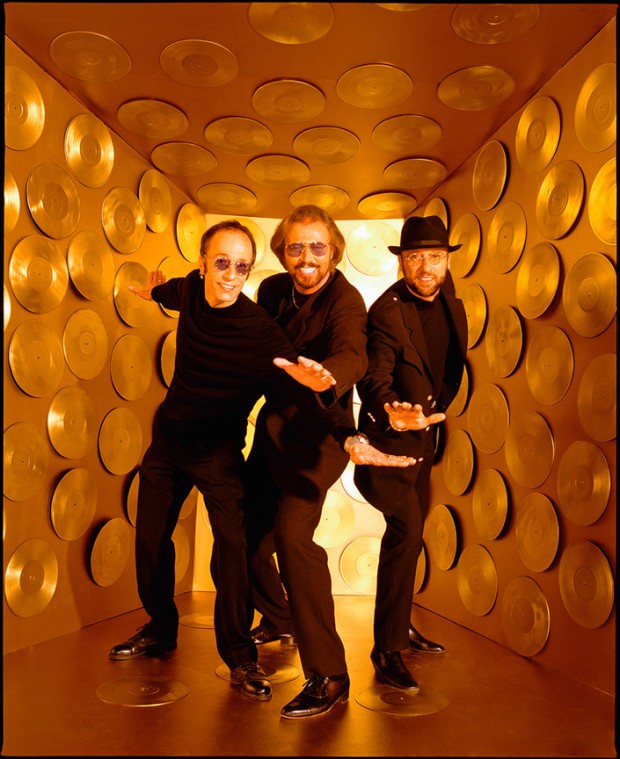
The Bee Gees photographed for Entertainment Weekly
My favorite assignments are the one's where I have a clean slate to shoot whatever I want. It's a fun challenge narrowing "everything" down to a manageable idea.
When I got a call from Entertainment Weekly to shoot the Bee Gees during their comeback tour, my first call was to their manager who offered up their recording studio as a location. From a historical perspective, the studio was interesting, but visuallyâ”not so much. Instead, I asked about shooting at one of their homes in a room filled with their gold records, but their manager swore no such room existed. Not one to let my ideas get shot down without a fight, I decided to create a room filled with nothing but gold records. I headed to Home Depot for paint and materials to build the set while my wife and stylist, Fazia, hit the thrift stores, where she picked up 100 LPs at 50 cents a pop.
After two days of building and painting the set, the Brothers Gibb showed up in an all-black wardrobe as requested and acted like true pros throughout the shoot. When I explained that the concept was based on a room that I thought they should have in their homes, they laughed and said, "Yeah, we'll have to think about that."
I'm often asked if it would be easier just to shoot subjects on green screen and add the background in post. Sure you can do that, but having a set allows your subjects to get in the mood and interact with the props – plus you'd miss the fun when the subjects show up and realize they're being photographed by a crazy person.
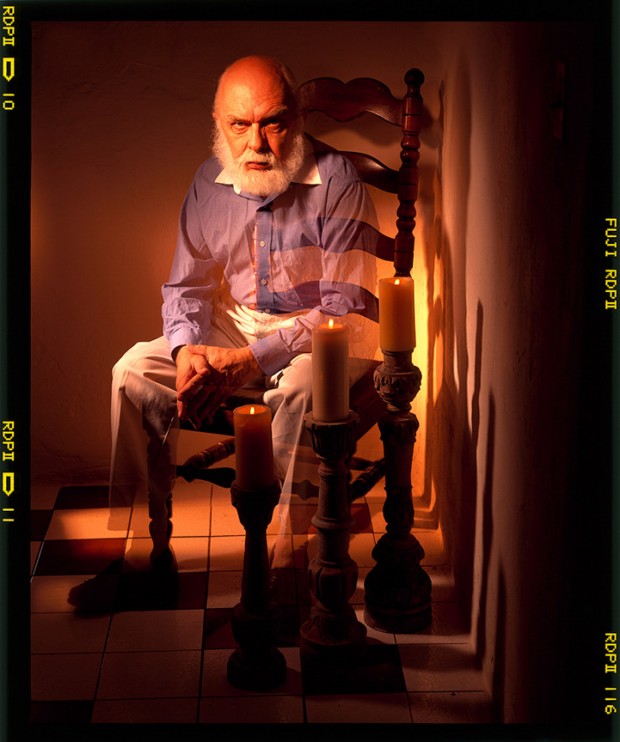
The Amazing Randi photographed for Esquire
The best idea in the world is worthless if you can't convince your subject to play along. Esquire magazine assigned me to shoot "The Amazing Randi" who'd been awarded a MacArthur Grant for exposing psychic frauds from faith healers to spoon benders. I'd shot Randi before, which usually makes things easier but also raises the stakes a bit because you always want to outdo what you did the last time. Plus this was Esquire, for God's sake.
I wanted to do something this time that would be worth a second look. I came up with the idea of making him disappear. When I got to Randi's house for the shoot, I explained my idea to him, but he quickly shot it down as the dumbest idea he'd ever heard. I asked him to wait to see it before making up his mind, and he trusted me enough to give me a chance to show him what I had in mind before passing final judgment.
Seeing is believing, so I set up my camera to show him a test. To get the effect I wanted, I shot an old-school double exposure on a single sheet of Polaroid. The first exposure was lit with a strobe with a grid spot that froze an image of Randi's face, shoulders, and legs. So as not to disturb the position of the chair, I asked Randi to get up carefully and then made a second exposure with only tungsten spots and candlelight to open up the areas that were in shadow in the first shot, thus allowing Randi to "disappear."
When Randi saw the Polaroid, he loved it! No Photoshop tricksâ”everything was done in-camera; there was no need for post. We quickly shot four rolls of film and were done. Sometimes the hardest part of the shoot is figuring out how to "sell" your idea to your subject.
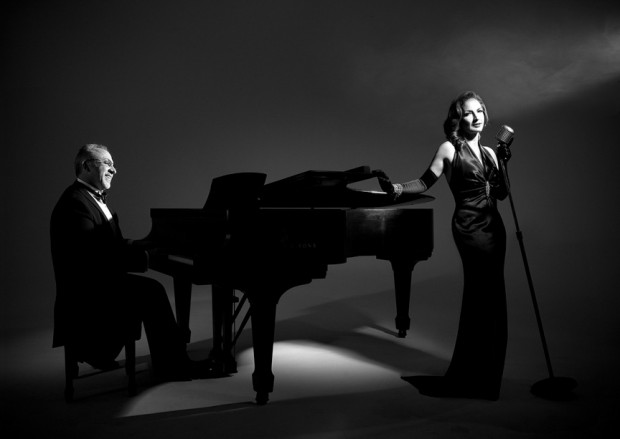
Gloria & Emilio Estefan photographed for People en Espa±ol
One of the first shoots I did after moving to Miami was to fly down to Mexico to photograph Gloria Estefan and the Miami Sound Machine for The Miami Herald. Gloria and her husband Emilio and I became friends on that trip, and over the next decade, I photographed Gloria many times for many different magazines.
People en Espa±ol called looking to do something special of Gloria and Emilio for the magazine's tenth anniversary issue. I thought back to an idea I'd pitched years before - shooting them in black-and-white with the feel of a 1950s Havana nightclub. We never got a chance to shoot it and this seemed like the perfect time. People en Espa±ol's creative director Herman Vega loved the idea and agreed it should run in black and white.
The shot was very simple, or at least as simple as a shot with a grand piano trucked into a studio can get. To complete the look, we brought in a vintage 1950s microphone and wardrobe. A smoke machine added a smoky, jazz club atmosphere. Lighting matched the retro look: No soft lights were used, only Fresnels and other hard lights.
Hope to see you all at Photoshop World in Las Vegas this September 4-6. In addition to my talk about conceptual portraiture, I'll also speak about ways that you can turn personal projects into jobs. You can Save $100 if you register by August 2nd - so do it TODAY! Photoshop World is three great days packed full of intense training in Photoshop, Lightroom and photography lighting techniques. This year is the greatest deal ever! With your paid registration to Photoshop World Vegas, you'll get an entire year of the Adobe Creative Cloud Free!
Come see me there!
Turning Your Personal Photography Projects to Profit
Wednesday, September 4, 2013
2:30pm - 3:30pm | Bonus Classes, NAPP Expo Theatre
Your best work is the work that comes from the heart. Learn ways that personal photography projects can land you jobs you'll love to shoot. I'll talk about ways to maximize the impact of your projects though blogs, promos and social media to generate work.
Conceptual Portrait Photography: Selling Your Ideas
Thursday, September 05, 2013
10:45am - 11:45am | Photography Technique
I'll share the way I comes up with concepts for portraits of the famous and infamous. Hear my tricks about how to sell those ideas to your subject and client. You'll hear the behind-the-scenes stories of how we pulled off conceptual portrait shoots for magazines like Esquire, GQ, Time, Sports Illustrated and ESPN the Magazine.
________________________________________
Miami Photographer Brian Smith photographs iconic portraits of Hollywood's A-List stars and Fortune's 500 for hundreds of magazines including Time, Sports Illustrated, ESPN the Magazine, Elle and GQ. He's a Pulitzer Prize-winning photographer and author of Secrets of Great Portrait Photography and Art & Soul: Stars Unite to Celebrate the Arts. See more of his work at Brian Smith Pictures and follow his photo blog, Facebook and Twitter .



Thanks for sharing Brian. I love the Steve Job connection to your Gate’s shoot.